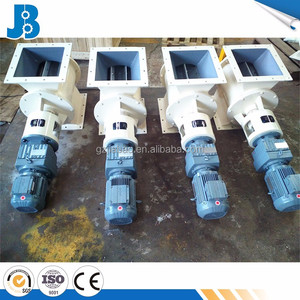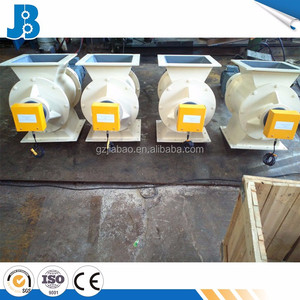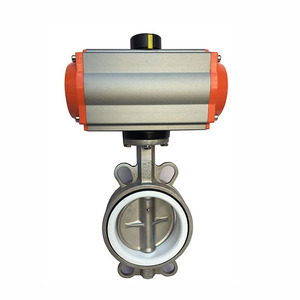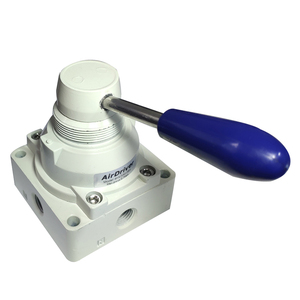
All categories
Featured selections
Trade Assurance
Buyer Central
Help Center
Get the app
Become a supplier

(1145 products available)



























Rotary valves for pneumatic conveying systems are made in different types. Every valve type helps to convey specific materials. These materials could be either powder or bulk. They also help to give room for the efficiency of rotary valves in varying application settings.
These valves handle light to moderate loads. They particularly do well with powders and granules of a smaller density. Such materials include flour, sugar, and plastics. These powders tend to get compacted easily.
A standard-duty valve has less wear-resistance material compared to heavy-duty valves. It is one of the most popular rotary valves. They are normally used in industries with light material flow.
This type of valve is designed for tough applications. These applications involve conveying heavy materials. These materials could include cement, minerals, or large granules of chemicals. A heavy-duty rotary valve is constructed with thicker materials.
This guarantees enhanced durability and wear-resistance properties. These features ensure that they can handle higher loads and more abrasive substances. Therefore, they make pneumatic conveying more efficient in harsh conditions.
The vacuum rotary valve operates under negative pressure. This helps to minimize dust formation in materials that generate particulates during conveying. Such materials include activated carbon, sawdust, and powdered chemicals.
This valve type normally seals tightly to prevent air leakage. It ensures that the material being conveyed doesn't escape into the environment. Also, the valve prevents air from entering the conveying line. This protects the system from contamination.
A mill rotary valve is used to convey materials subjected to grinding or milling. These materials include pigments and minerals. This valve type normally features specially designed rotors with narrow and tight pockets.
These pockets ensure a consistent discharge rate of finely ground materials. In addition, the design prevents material clumping or blockages. It also prevents products from getting purged back into the system.
Rotary valves in a pneumatic conveyor system offer great versatility. This versatility makes them critical components in various industries. These industrial applications benefit from the efficiency and reliability of the valves.
This industry normally uses pneumatic conveying to move bulk food ingredients. These ingredients include grains, sugars, and powdered milk. The pneumatic rotary actuator helps in the precise transfer of these materials without causing any contamination.
This preservation of food quality is critical to this industry. Therefore, rotary valves find their application in feeding and metering these materials during conveying. The Food and beverage industry also utilize these pneumatic conveying systems to transport packaging materials. Such systems include plastics and glass components.
This industry has seen a wide application of pneumatic conveying rotary valves. It uses them to transport numerous powdered and granular chemicals. These materials could be as hazardous as they come. Therefore, using these valves ensures safety during transfers.
The valves control material flow precisely. This regulation makes it possible for the chemicals to be moved consistently. The heavy-duty designs of these rotary valves also guarantee durability when conveying abrasive substances.
This industry has stringent requirements for material handling. It relies on pneumatic conveying systems to transport active pharmaceutical ingredients (APIs) and excipients. The pharmaceutical pneumatic conveyor valves in this industry are responsible for precisely dosing these materials.
They also do segregation without cross-contamination. This ability is crucial for product purity in this industry. The pharmaceutical industry also favors vacuum rotary valves. These valves prevent dust formation during conveying. They help to create a safer work environment.
In this industry, rotary valves are employed to handle heavy materials. These materials include ores, minerals, and abrasives. The heavy-duty valves are ideal for conveying these substances. They ensure smooth operation even under challenging conditions.
These valves are critical for feeding the mined materials into processing equipment. They also regulate the material flow to prevent blockages. Besides, they help in maintaining the production process's efficiency.
For one to choose the right pneumatic conveying rotary valve, there is a need to consider the factors affecting durability and maintenance. These factors are key since they directly impact the valves' operational efficiency.
Rotary valves are made from many materials. These materials include cast iron, stainless steel, and other alloys. Each of these materials comes with its own benefits. Stainless steel, for example, has great resistance to corrosion. This feature makes it ideal for use in the food and pharmaceutical industries.
On the other hand, cast iron is much more durable. That feature makes it suitable for heavy-duty manufacturing applications. The material of choice determines the maintenance requirements as well as the valve's lifespan.
Rotary valves normally experience abrasion when they are used to handle abrasive materials. It consequently leads to rotor and housing wear. The material's wear-resistance coatings help to minimize this wear and extend the life of the valve. These coatings could be ceramic, hardfacing, or carbide. They reduce the rate of wear.
By reducing wear, the coatings also minimize the need for frequent maintenance. This maintenance can be costly and time-consuming. Industries dealing with coarse powders or granular materials benefit most from these wear-resistant coatings.
Rotary valves are designed to operate under specific pressure conditions. If a valve exceeds these conditions, it can lead to premature failure. Operating in high-pressure environments also subjects the valve to higher wear rates.
This condition can be avoided by selecting a valve rated for the required pressure. This selection ensures that its burden capacity is compatible with the material flow rate in the given application.
Failure of sealing mechanisms is one of the most common causes of contamination and material loss. Advanced sealing mechanisms ensure that the valve maintains a tight seal during operation.
These mechanisms also help reduce maintenance costs by preventing leaks. Leak prevention minimizes product loss and lowers operating costs. Industries with high-value materials see the importance of investing in valves with quality sealing mechanisms.
The market avails a plethora of pneumatic conveying rotary valves. Although they all share the same functions, choosing one that will serve the buyer's customers effectively is paramount. Below are several factors to consider when selecting these valves.
The various pneumatic conveying applications require different rotary valves. For example, the mill rotary valve is specifically designed for fine materials. These materials have undergone milling or grinding.
This valve prevents clumping during the conveying process. On the other hand, the vacuum rotary valve is designed to operate in a negative pressure environment. This operation minimizes dust formation. The heavy-duty rotary valve is constructed with thicker materials.
These durable materials help them withstand higher loads. They also cater to more abrasive substances. The diversity of the rotary valve types serves different material and industry needs. It, therefore, makes it easier for the buyers to meet the various customer demands.
Different industries have varying requirements for their pneumatic conveying systems. It is essential to consider the specific needs of the industries customers. Doing so ensures that the conveyed materials move efficiently and safely.
For instance, the pharmaceutical industry demands high precision and anti-cross-contamination pneumatic rotary valves. The chemical industry needs heavy-duty variants for those harsh applications. Therefore, selecting a valve that meets the customer's industry demands ensures operational efficiency.
Rotary valves handle a wide range of materials. Those materials can be in the form of powdered, bulk, or granular substances. To ensure successful conveying, choosing valves that are compatible with the conveyed materials is critical.
For instance, standard-duty valves are ideal for light and non-abrasive materials. As for heavy-duty valves, they are more suited to tackle heavy or coarse materials. At the same time, vacuum valves are designed to work with fine powders.
Buyers should also look into the maintenance requirements. For example, people prefer valves with wear-resistant materials. These materials prolong the life of the valve while minimizing downtime from frequent maintenance.
Again, valves with easily accessible components reduce the time spent on maintenance. Buyers also need to cater to clients looking for rotary air locks with advanced sealing mechanisms. They help to prevent product loss and reduce operating costs.
The main difference between the two lies in how they operate. Manual valves rely on human intervention for material flow control. On the flip side, rotary valves are powered by pneumatic systems. They automatically regulate material flow.
Rotary valves do require maintenance. Although they do not require complicated procedures, regular checks for wear, tear, and seal integrity are essential. Manufacturers always recommend specific maintenance practices. Buyers should follow them to ensure optimal performance.
A person will know the valve is worn out by checking for signs like air leaks, reduced efficiency, or abnormal noises. Material backflow is another indicator of a worn-out valve.
These valves have no uniformity. Each industry utilizes valves that are specifically designed for unique applications. Those applications involve the nature of the conveyed materials, system pressure, and environmental conditions.
Rotary valves control the flow of powders in pneumatic conveying systems. They act as feeders that manage the powder's discharge rate from storage or processing equipment.